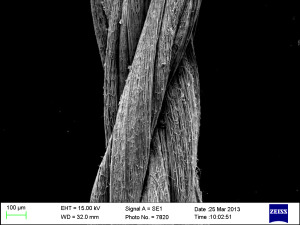Manufacturing continuous nanofibrous filaments

A novel method of manufacturing electrospun filaments that are biologically active and biocompatible. The technology has many application including sutures and other medical devices with good tensile properties and biodegradability
Electrospinning and electrospun materials have been known for decades however there is still no methodology to generate continuous filaments in a robust and reliable manner, based on that technology.
Researchers at the University of Oxford have now developed an automated method and device for the collection of continuous filaments made of micro- and nano-scale fibres. The methodology uses the same basic principle as electrospinning using a charged polymeric solution. The Oxford invention opens up the possibility for nanofibrous yarns to replace current medical fibres. Applications include implantable medical textiles such as sutures and tissue engineered scaffolds, and textiles in general.
New possibilities in medical textiles
Nanoscale fibres have recently been identified as exceptional candidates for improved healing to damaged tissues and organs. Because of their extremely fine dimensions, nanofibrous materials possess a very high surface area to volume ratio and porosity. This means that they can rapidly absorb large volumes of fluids; display high exchange rates of gas and liquids; carry and release drugs in a controlled way; and contain biologically active agents. Due to their inherent dimensions, they can also mimic the extracellular environment, making them excellent materials to support cell growth and new tissue formation. Replacing current medical fibres by nanofibrous threads has therefore a huge potential to improve the healing function of tissues and organs.
Applications in the medical textile field include:
- Surgical sutures
- Tissue scaffolds for tissue engineering
- Wound dressings
- Drug releasing devices
Other applications beyond these include:
- Textiles
- Filtration
- Electronics
Automated device for continuous production
The production of strong, consistent and continuous nanofibrous threads has been challenging due to a lack of reliability and robustness of the technologies currently available. The Oxford invention overcomes these limitations and delivers all the above benefits whilst offering unique features.
Some of the features include:
- Potential to produce very long filaments (as needed)
- Various diameters of filament are possible
- Production of either nanoscale and microscale fibres
- Suited to a wide range of polymers
- Suitable for bioactive agent incorporation
about this technology

